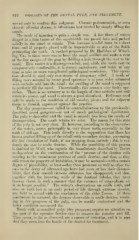Page 900 - My FlipBook
P. 900
910 DISEASES OF THE DENTAL PULP, AND TREATMENT.
served only to confirm this judgment. Chronic pericementitis, or even
chronic alveolar abscess, is oftentimes best treated by simply filling the
canals.
The mode of insertion is quite a simple one. A few fibres of cotton
dipped in a thin batter of the oxychloride are passed into and packed
solidlv in the canal or canals. This becomes a solid mass in a short
time, and if properly placed will be impenetrable to any of the fluids
permeating the tooth. A method proposed by Dr. Hullihen of Wheel-
ing, Va., in these cases was to leave the canal unfilled and make a vent
at°the free margin of the gum by drilling a hole through the root to the
canal. This makes it a drainage-conduit, and, while the tooth may be
is always malodorous and liable at any
comparatively comfortable, it
time to take on more complicated pathological conditions. This opera-
tion should be used only as a means of temporary relief. A mode of
filling roots adopted by many good operators is to pass cedar saturated
with carbolic acid into the canal ; the swelling of the wood is supposed
to perfectly fill the canal. Theoretically, this seems a very faulty ope-
ration. There is no certainty as to the length of time carbolic acid will
retain its power, and wood is always a good absorbent. Reference need
only be made to the condition of old wooden pivots and the adjacent
tissue to furnish argument against the practice.
The dry gangrene—so called in contradistinction to the previously-
described moist gangrene—is not of much pathological significance.
The pulp is shrivelled and the canal is entirely free from the results of
decomposition. The tooth retains its color. The reason for this state
of the pulp is not very clear. It, however, according to the observation
of the writer, occurs principally in very dense teeth, especially in the
teeth of old age. This leads directly to the supposition that there has
been a gradual filling up of the tubuli with secondary dentine, preventing
the free circulation of fluids, if not stopping them entirely ; this is evi-
dently the case in senile dentine. AVhile the possibility of this process
is doubted by Wedl, who regards the translucency described by Tomes
as dependent on the continuation of the " process of the dentine cells
existing in the translucent portions of senile dentine, and that, as they
still retain the property of imbibition, it may be assumed—with a certain
degree of plausibility, at least—that these processes as well as other tis-
sues in the decay of advanced age have lost more or less their distensi-
bility, that their central vitreous substance has disappeared, and that,
together with the investing walls of the dentinal tubules, they have
become closed in such a manner that the entrance of atmospheric air
is no longer possible." The writer's observations on senile teeth, and
also on teeth lost at an early period of life through extreme density,
are fully in accord with the conclusion of the elder Tomes. If these
conclusions be accepted, the dryness observable in senile dentine, result-
ing in dry gangrene of the pulp, can be readily understood and the
latter condition accounted for.
Teeth with mummified pulps (dry gangrene) require no attention on
the part of the operator further than to remove the remains and fill.
They never, so far as observed, are a source of irritation, and it is rare
that thev come into the hands of the dentist for treatment.


